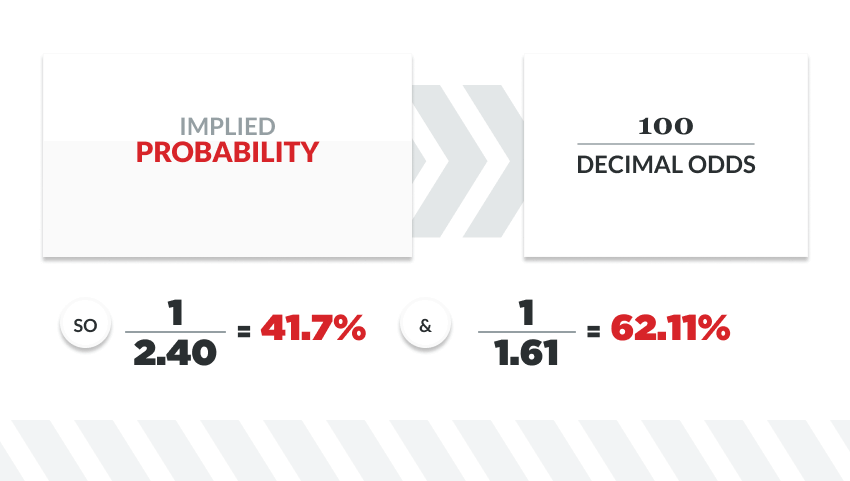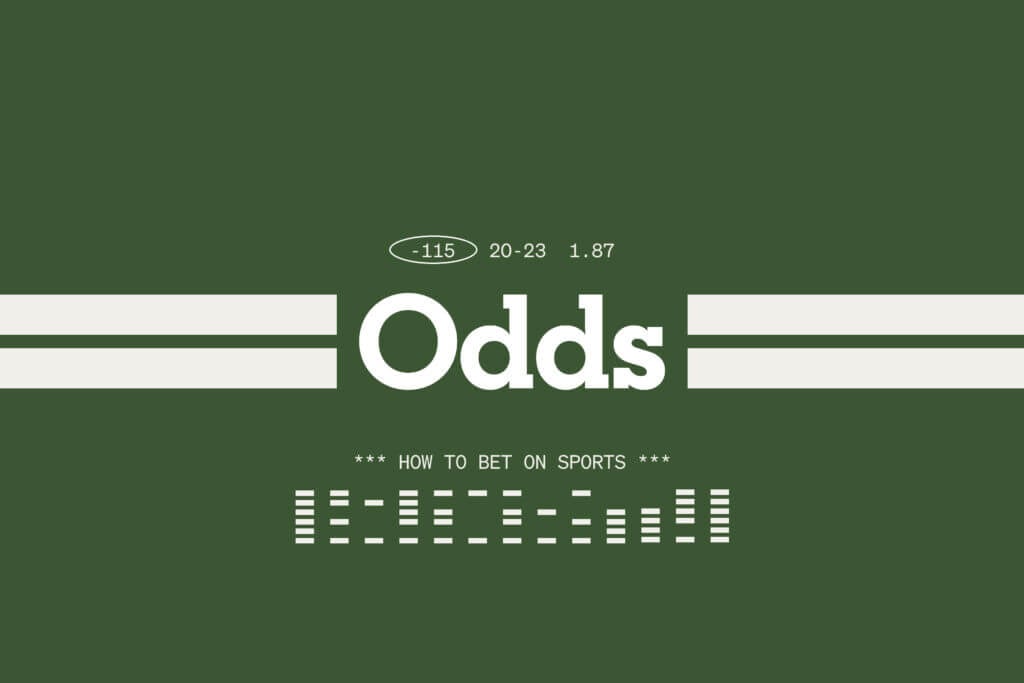How to bet odds on sports

Understand the Basics of Betting Odds · Step 1 Bet on point spreads. · Step 2 Place a bet on the money spread. · Step 3 Put your money down on the totals. Calculating fractional odds is fairly straightforward. It is determined by multiplying the amount wagered by the fraction. For example, a bet of. Bookmakers set odds based on their own assessment of the likelihood of each outcome. They also take into account the amount of money that has been wagered on. Decimal Odds. Decimal odds show the total return from a $1 bet. The higher how to bet odds on sports number, the more you win, but your wager comes with more risk. Your total return.
Mastering the Art of Betting Odds on Sports
As a sports enthusiast, understanding how to navigate and conquer the world of betting odds on sports can be a thrilling journey. It's not just about placing a bet; it's about analyzing, predicting, and ultimately triumphing in the realm of sports betting.
The Basics: Deciphering Odds
When stepping into the world of sports betting, one encounters various odds formats such as decimal, fractional, and American. Deciphering these odds is crucial in making informed decisions and maximizing potential returns.
Calculating Probability: A Skill Worth Mastering
Behind every odd lies a probability waiting to be dissected. By understanding the relationship between odds and implied probabilities, bettors can gain an edge and make strategic decisions.
The Art of Value Betting
Value betting is the holy grail of sports betting. It involves identifying odds that are undervalued by the bookmakers, thus providing an opportunity for long-term profitability.
Embracing Data: Leveraging Analytics
Modern sports betting is a blend of tradition and technology. Utilizing data analytics, statistical models, and trends can greatly enhance one's ability to make informed bets and stay ahead of the curve.
Bankroll Management: The Key to Longevity
One cannot overstate the importance of bankroll management in sports betting. Setting a budget, defining staking plans, and avoiding emotional decisions are pivotal in ensuring a sustainable and enjoyable betting experience.
A Word of Caution: Responsible Betting
Amidst the thrill of sports betting, it's essential to practice responsible gambling. Setting limits, knowing when to take a break, and seeking help if needed are fundamental in maintaining a healthy relationship with sports betting.
The world of sports betting is vast and ever-evolving. By honing your skills in understanding odds, calculating probabilities, embracing data, practicing value betting, and managing your bankroll, you'll be better equipped to navigate this exciting realm with confidence and success.
How to read and calculate sports betting odds
How are sports odds calculated? In American sports betting, odds are typically expressed with a plus (+) or minus (–) symbol followed by a number. For example, +200 signifies the amount a bettor could win if wagering $100. If the bet works out, the player would receive a total payout of $300 ($200 profit + $100 initial stake).
How do you read odds? Odds of 7/5 mean you'll win $7 for every $5 you wager on the A's. Conversely, the Rangers' odds of 5/8 mean you need to wager $8 to win $5 on Texas. Another way to look at it: If the first number is larger than the second, you're betting on the underdog for a higher potential payout.
How do you calculate odds to win? This is found by dividing the number of desired outcomes over the total number of possible outcomes. In our example, the probability (not odds) that we'll roll a one or a two (out of six possible die roll outcomes) is 2 / 6 = 1 / 3 = . 33 = 33%. So our 1 : 2 odds of winning translate to a 33% chance that we'll win.
How do you read odds to win? For favored bets, the bet odds will start with a negative number and they tell you how much you need to bet to win $100. If the odds are -110, a common number for a bet involving a spread, you would need to bet $110 to win $100. If the odds are positive, they tell you how much you will win if you bet $100.
How do you identify odds? Odds are presented as a positive or negative number next to the team's name. A negative number means the team is favored to win, while a positive number indicates that they are the underdog. Ex: Dallas Cowboys, -135; Seattle Seahawks, +135.
What does 15 8 odds mean? So 15-8 is fifteen divided by eight which is 1.875. So 15-8 is in fact 1.875-1 or just under 2-1. We can do the same with 100-30 which is 100 divided by 30 which is 3.33 and so 3.33-1. In Fractional Odds, When the First Figure is higher than the Second Figure; this is referred to as Odds Against.
What does 7 to 1 odds pay? The odds and what they mean
| Odds | Payoff range |
|---|---|
| 5-1 | $12.00-$13.90 |
| 6-1 | $14.00-$15.90 |
| 7-1 | $16.00-$17.90 |
| 8-1 | $18.00-$19.90 |
Understanding sports betting odds and calculating value bets
Fractional odds aka "British odds," "U. Let's posit that the following are the odds on the three teams most likely to win the NBA Championship:. It can quickly be determined that the Brooklyn Nets are the favorites, while the perceived odds of Golden State or Milwaukee winning are longer. Decimal odds aka "European odds," "digital odds," or "continental odds" are popular in continental Europe, Australia, New Zealand, and Canada.
These are a bit easier to work with and understand. The favorites and underdogs can be spotted instantaneously by looking at the numbers. In other words, your stake is already included in the decimal number no need to add back your stake , which makes the calculation easier. Let's look at an example involving who might have won the U.
Suppose the decimal odds were:. Here we can see that the bookmaker correctly priced Biden as the favorite to win the election. The higher the total payout i. Simply put, the greater the odds against a team, the larger the payout will be for anyone who bets on it. You stand to make more money on positive odds, but the chances of a win are lower.
Vegas odds aka "Las Vegas odds" are a form of American money line odds used in sportsbooks. They can include a point spread representing the expected margin of victory. This allows bettors to wager not only on the winner but over or under the bookmaker's predicted point spread. American, British, and European odds are three different ways of expressing the same thing and can be converted from one to another.
By understanding all three and how they work, you'll increase your own odds of placing well-informed if not always successful bets. If you or someone you know has a gambling disorder, please call the National Problem Gambling Helpline at , or visit ncpgambling. How to bet odds on sports The National Law Review. American Gaming Association. The decimal odds would be listed at 1.
Multiply the odds by the bet and you get the return that would include the original bet. Much easier, right. This is a case where decimal odds can be better. However, they are presented, being able to convert your odds into a break-even percentage is a crucial part of understanding what is actually a good bet.
If you think the likelihood is higher than that, it is a good bet. This is similar to pot odds in poker, for example. Think of a coin flip. You know you know have a one-in-two chance of heads coming up. Slingshot gives a percentage chance of an upset happening.  That percentage can be compared to moneyline odds , once you convert the odds to a percentage.
That percentage can be compared to moneyline odds , once you convert the odds to a percentage.
If the model thinks the odds are significantly better than what the bet is offering, and you trust the model, this can be a useful tool in whether to decide to place a bet or not. Get all-access to exclusive stories. Subscribe to The Athletic for in-depth coverage of your favorite players, teams, leagues and clubs. Try a week on us.
Dan Santaromita is a senior editor for sports betting at The Athletic. He is a University of Missouri graduate who resides in Chicago. Live News. Premier League. Champions League. Copa America. La Liga. Europa League. International Football. We've received your submission. And for fractional odds, which are perhaps most commonly seen during horse races, the numerator details the number of times the bookkeeper expects the result to fail while the denominator illustrates the number of times they expect the result to succeed.
Already got it down. Check out these sportsbook promo codes before signing up for an account:.
Popular Pages
- When does sports betting start in new jersey
- Can i bet on sports online in north carolina
- Does pennsylvania have sports betting
- What is a whale in sports betting
- Can you cancel a sports bet
- Is sports betting ethical
- How to program sports betting robots
- How to bet on sports in florida
- Can sports bet be enough for a living
- Why is sports betting bad